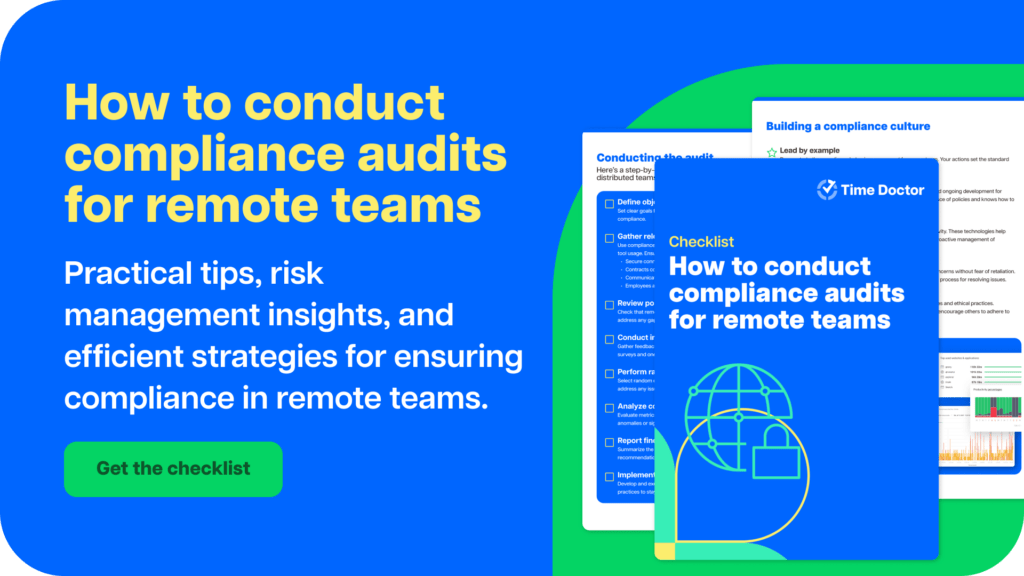Want to know how to increase accountability in the workplace?
Missed deadlines, repetitive mistakes, and a lack of trust and engagement can be a sign of poor accountability.
However, picking up on these signs isn’t the end of it. You need to work on them too.
So how do you increase accountability in the workplace?
In this article, we’ll cover what accountability is and why it’s important for your business. We’ll also highlight nine tips to improve accountability in the workplace.

Table of Contents
- What is accountability?
- Why should you increase accountability in the workplace?
- How to increase accountability in the workplace?
- Frequently asked questions (FAQs)
Let’s get started.
What is accountability?
Generally, accountability refers to the obligation of accepting responsibility for one’s actions.
Accountability is nearly impossible when responsibility is unclear. Based on Gallup study findings, approximately only half of employees are familiar with their employer’s expectations.
An employee’s accountability includes delivering on their work commitments, such as:
- Completing assigned tasks with quality output.
- Delivering projects within the given deadline.
- Taking responsibility for their performance.
- Owning their roles and responsibilities towards their organization.
On the other hand, a manager’s accountability revolves around their team’s success.
To elaborate on this, a manager’s accountability means:
- Achieving results for the organization.
- Boosting employee motivation for better engagement.
- Establishing effective communication.
- Handling work conflicts.
But why do you need to build an accountable organization?
Lack of accountability can lead to issues like:
- Missed deadlines.
- Unachieved targets and goals.
- Lower employee morale.
- High employee turnover rates.
If you’re noticing these red flags in your current workplace culture, it’s time for you to take some action.

Why should you increase accountability in the workplace?
Let’s take a look at three common reasons why accountability is important in the workplace:
1. Boosts employee engagement
Greater employee engagement can lead to higher productivity levels.
How?
An accountable person focuses on their work and collaborates with their team members to deliver key results.
They also actively participate in:
- Seeking feedback from their manager or teammates.
- Taking ownership to work on their shortcomings.
- Finding innovative solutions for challenges.
Promoting such activities helps deliver tasks on time while boosting employee satisfaction, engagement, and workplace harmony.
Moreover, an accountable system avoids instances of micromanagement, which in turn builds trust among employees. This environment allows employees to focus on their work — as they feel their team members won’t judge or criticize them if they make a mistake.
2. Helps build trust
Having a team full of employees who never accept responsibility for their actions can foster a toxic organizational culture.
Employees might feel that their co-workers will blame them so they can get out of tricky situations.
But when done the right way, team accountability helps build trust.
How?
When people feel you have treated them fairly, they might like you and would actively listen to you in the future.
This positive connection encourages your employees to be more accountable towards their commitments, building trust along the way.
Moreover, when everybody answers for their own performance, employees feel confident that their team members will support them even if they make a mistake.
3. Improves performance
One of the qualities of an accountable employee is that they’re aware that their tasks and achievements directly affect the organization’s results.
That’s why they set clear goals to complete their tasks and provide quality work.
This drives them to give their best for small tasks and critical projects, leading to high performance and greater organizational success.

How to increase accountability in the workplace?
Let’s take a look at nine tips to create a more accountable workforce:
1. Lead by example
The actions of accountable leaders hold a lot of weight. They are responsible for setting the tone, performance, engagement of the team.
So, if a manager frequently shows up late for team meetings, pushes deadlines, and doesn’t own up to their mistakes, their team members will feel there’s nothing wrong with behaving the same way.
Additionally, you can’t hold your team accountable for something that you don’t follow.
That’s why you should also meet the standard set for your team members and hold yourself accountable for your undelivered commitments.
How to lead by example
You can follow a few measures, such as:
- Finishing projects within deadlines.
- Discussing the cause for unachieved goals.
- Practicing punctuality by being on time for the team meetings you schedule.
- Holding employees accountable regardless of their position in the organization.
2. Set clear expectations
Employees can’t hold themselves accountable if they aren’t aware of what’s expected of them.
With expectations and challenges constantly changing, you need to ensure that you’ve properly laid down each task’s expected standards and results.
Doing so clarifies things further – making it easier for your entire team to accept responsibility for their commitments and actions.
Additionally, unclear standards can also lead to toxic employee behaviors such as:
- Publically airing grievances against managers.
- Causing frequent conflicts.
- Unfair dismissal claims, etc.
How to set a clear expectation
To increase transparency at the workplace, you can:
- Clearly define monthly targets, objectives, KPIs (Key Performance Indicator), and other metrics.
- Provide meaningful feedback.
- Share essential project-related information like project timelines, workflows, and more.
- Conduct one-on-one conversations to discuss project progress.
3. Set achievable goals
Understanding the bigger picture will help employees realize where they fit in, and consequently, take accountability for their responsibilities.
Once employees clearly understand what they’re accountable for, managers should help them set measurable, individualized goals that align with their roles.
Employees should also have metrics defined that help them know if they’re delivering on the organization’s goals.
However, these goals should be attainable.
As a responsible manager, you should involve your team members in the goal setting process for both personal and team-wide objectives instead of simply setting it up for them.
How to set achievable goals
To overcome consistent lack of accountability at work, you can create some SMART goals.
What is a SMART goal?
SMART is an acronym that expands to Specific, Measurable, Achievable, Realistic, and Timely.
This means a SMART goal should be in accordance with all of the criteria mentioned above.
For example, for a sales employee, the SMART goal can be to “close 50 prospects in the third quarter.”
This goal is specific as it mentions the number of prospects and can be measured against the actual numbers. Moreover, it’s achievable and realistic as the number isn’t too high and has a timeline of three months.
4. Have frequent conversations
Employees might find it difficult to understand how their behavior and performance impact their teammates and organization.
That’s why you need to determine the root cause of poor performance.
As you can’t work towards a solution unless you confront the problem, you would need to schedule a one-on-one performance review as quickly as possible.
However, discussing employee accountability doesn’t have to be stressful or confrontational.
You can simply take it as an ongoing conversation and set up a time for regular follow-ups to ensure a continued discussion.
Additionally, you should keep the meetings’ objectives clear so you can follow through with the progress from the previous session.
This regular check-in makes room for more natural conversations and keeps employees from feeling threatened by one-on-one meetings.
How to have meaningful conversations with employees
To ensure that your conversation with your employees goes smoothly, you can:
- Plan out the conversation in advance.
- Be direct with your concerns.
- Clarify things by citing examples.
- Focus on your words and tone.
- Offer solutions that you deem fit.

5. Provide feedback
Occasionally, the reason for unmet goals could be a lack of training for new employees. However, in the case of an experienced employee, it could be due to an overpacked schedule.
Either way, you can reinforce the set expectation by providing candid feedback and letting employees know where they stand. This helps them accept more personal accountability for their goals and performance.
Feedback and some accountability training can help you achieve positive results with conscientious employees. But in severe cases, you might need to be stricter.
Regardless, you should be clear about the behavior and improvements you expect from the employees going forward. You can also give valuable suggestions for how to make that happen.
How to provide actionable feedback
Here’s what you can do when providing feedback to new and experienced employees alike:
- Discuss their progress towards monthly goals.
- Focus on current challenges or roadblocks that the employee is facing.
- Answer their questions and concerns to your best ability.
- Use storytelling to leave more impact.
- Be sensitive and show empathy.
- Appreciate their wins and achievements.
- Ask employees if they agree with the feedback and if they have any questions.
6. Be considerate
Remember, there’s always a reason behind everything.
For example, if an employee is reaching late to work every day or skipping work frequently, it could be due to unavoidable circumstances.
They could be a working parent who needs to drop their kids at daycare, or they might have to look after a special needs adult at home.
Instead of assuming things or using a harsh tone to address this issue, you should talk to them to find the root cause of their problems. You can explain to them the impact of their behavior.
Moreover, throughout the conversation, ensure that your actions don’t diminish employee morale.
How?
You need to be empathetic towards both employee and company commitments.
How to be considerate
To deal with such situations, you can suggest some flexible work options like:
- Grant permission to work from home or a remote location.
- Offer part-time positions.
- Allow your employees to follow a flexible schedule like flextime and compressed workweek.
Read our article on how to create a flexible work environment.
7. Create an environment of trust
Inculcating a sense of fear among employees may provide immediate results, but it doesn’t contribute to long-term accountability.
Employees who don’t feel secure at their jobs are less likely to hold themselves accountable for mistakes due to the fear of authority.
Moreover, constantly criticizing your employees without any praise can lead to your employees losing trust in the leadership team.
How to create an environment of trust
The key to building accountability is not punishing employees every time they make a mistake but encouraging them to hold themselves responsible for their actions.
By creating an environment based on trust, you open up lines of communication so employees can admit to mistakes and shortcomings more easily.
To create an environment of trust, you can adopt a few measures like:
- Avoid micromanaging your employees.
- Encourage regular team interactions to learn more about them.
- Conduct remote team building activities to build stronger bonds.
- Praise and reward hard work and achievements.
8. Maintain equilibrium
At times, an employee’s undelivered commitments can be due to a lack of clarity from your side.
In this case, you should demonstrate accountable behavior. You can provide them with the proper resources or give them another opportunity to prove themselves.
And if an employee fails to deliver due to their own lack of accountability, then you should take necessary actions, such as:
- Deciding not to entrust them with that level of responsibility again.
- Suggesting a training course to help them with their shortcomings.
- Or, in severe cases deciding to let them go.
The bottom line is that an employee’s lack of accountability can’t always be the cause of undelivered commitments.
That’s why you should maintain a balance in dealing with such situations and hold the right individual accountable.
How to maintain equilibrium
Along with holding people accountable and reprimanding them for their errors, you should also reward their achievements.
Here are a few ideas of rewards:
- Few lines of appreciation in front of their peers.
- Cash incentives or vouchers,
- Or even offering a promotion.
9. Use productivity monitoring tools
Monitoring productivity is a great way to foster a culture of accountability in the workplace. And necessary resources like employee productivity management tools help you do just that.
They help you identify an employee’s unproductive activities and areas of improvement. They also build transparency as managers know what their employees are doing during work hours.
How to use productivity monitoring tools
With hundreds of tools available, picking the right productivity monitoring software might sound daunting.
Fortunately, Time Doctor is a user-friendly solution that offers advanced features.
1. Time Doctor

Time Doctor is a workforce analytics software that gives managers actionable insights for for enhancing accountability and productivity.
- Manual and automatic time tracking to see how long an employee takes to complete a task.
- Performance reports to get a detailed breakdown of how they spend time.
- Productivity ratings for classifying websites and apps according to their productivity levels.
- Helps track remote team members’ inactivity for better productivity monitoring.
- A powerful Chrome browser extension for tracking time spent on other online apps.
- Payroll management to easily generate payroll for any member of your team.
- Third-party app integration with remote work tools like Google Workspace, Asana, and ClickUp.
2. Hubstaff
Hubstaff is another popular productivity monitoring tool that helps teams maintain accountability and manage time effectively. With features like time tracking, GPS tracking for field teams, and detailed productivity reports, Hubstaff makes it easy for managers to see where time is spent and improve workplace accountability.
Key features:
- Automatic time tracking to capture work hours.
- Activity level monitoring to ensure employees are active during work hours.
- Screenshots to give managers insights into what their team is working on.
- GPS tracking for mobile teams to monitor location-based work.
- Comprehensive reports for tracking project progress and time allocation.
3. Toggl Track
Toggl Track offers a simple yet powerful solution for tracking time and enhancing team accountability. With intuitive tools that make tracking work hours easy, Toggl Track helps businesses improve transparency and ensure employees stay accountable for their tasks.
Key features:
- One-click time tracking across desktop and mobile apps.
- Detailed reports on how time is spent, helping teams identify bottlenecks.
- Integration with popular project management tools like Asana, Trello, and Slack.
- Billable hour tracking to simplify invoicing for teams and freelancers.
- Time audits to ensure accountability for completed work.
4. Clockify
Clockify is a free time-tracking tool that helps teams stay accountable by tracking work hours and providing insights into productivity. It’s great for businesses looking for a cost-effective way to improve accountability without compromising on features.
Key features:
- Unlimited tracking for employees, projects, and tasks.
- Detailed reports that show exactly how time is spent.
- Billable and non-billable time tracking to maintain transparency in invoicing.
- A Chrome extension for easy time tracking while using other apps.
- Customizable dashboards for better visibility into team performance.
5. RescueTime
RescueTime is a time management tool that not only tracks how employees spend their time but also helps them become more productive by blocking distractions. It’s a great tool for fostering self-accountability and ensuring focus on important tasks.
Key features:
- Automatic time tracking to capture time spent on apps and websites.
- Distraction blocking feature to help employees focus on work.
- Daily productivity reports to assess performance and improve time management.
- Customizable alerts that notify employees when they spend too much time on certain activities.
- Goal setting to boost productivity and enhance accountability.
6. ActivTrak
ActivTrak is a cloud-based productivity monitoring tool that helps businesses ensure employees are accountable for their work. It tracks user behavior and provides insights into work patterns, enabling companies to optimize performance.
Key features:
- Real-time user activity tracking to monitor employee actions.
- Productivity metrics and insights for identifying areas of improvement.
- Alerts for any suspicious or non-compliant behavior.
- Customizable dashboards to visualize team performance.
- Integration with other workplace tools for seamless monitoring.
7. Teramind
Teramind is an advanced employee monitoring tool designed to help businesses keep track of employee activity and improve workplace accountability. It offers comprehensive features to monitor, control, and optimize team performance.
Key features:
- User activity tracking to capture all employee interactions with devices.
- Detailed reports on productivity, time usage, and behavior.
- Real-time alerts for unusual or suspicious activities.
- Screenshots and session recordings for enhanced transparency.
- Compliance monitoring to ensure adherence to company policies.
These tools, alongside Time Doctor, can significantly enhance accountability in the workplace by providing clear insights into employee activities, productivity, and time management.
productivity, and time management.
Frequently asked questions (FAQs)
1. How can managers improve their own accountability?
Managers can improve their accountability by leading by example. This includes owning their decisions, meeting deadlines, and providing regular feedback. They should also ensure clear communication with their team and hold themselves to the same standards they expect from others.
2. What steps can an organization take to foster accountability?
Organizations can foster accountability by setting clear expectations, providing measurable goals, offering feedback regularly, and using productivity tools. Creating an environment of trust, where employees feel safe to admit mistakes, is crucial for long-term success.
3. How do productivity tools help with accountability?
Productivity tools like Time Doctor help track employee performance, identify areas of improvement, and ensure transparency in work processes. These tools provide insights into how time is spent, which promotes self-awareness and accountability for meeting deadlines and delivering quality work.
4. What happens if accountability doesn’t improve despite taking action?
If accountability doesn’t improve after taking steps, it may indicate deeper issues such as poor team alignment, lack of skills, or disengagement. In such cases, consider revisiting goal-setting processes, offering further training, or re-evaluating team roles to ensure the right fit.
5. How can accountability be maintained in a remote work environment?
Maintaining accountability in a remote work setting requires clear communication, regular check-ins, and using the right tools to track progress. Managers should set clear goals, ensure team members have the resources they need, and promote a culture of trust where employees feel responsible for their tasks, regardless of location.
Wrapping up
Increasing accountability in the workplace can be a slow process.
You need to lay down the foundation and be patient – allowing everyone to adapt to the changes.
Moreover, along with building an accountable culture, you should create a comfortable work environment where employees understand their role, its impact, so they can easily collaborate to provide the best results.
Follow the tips mentioned in this article, and you’ll be able to increase workplace accountability with ease.

Liam Martin is a serial entrepreneur, co-founder of Time Doctor, Staff.com, and the Running Remote Conference, and author of the Wall Street Journal bestseller, “Running Remote.” He advocates for remote work and helps businesses optimize their remote teams.


